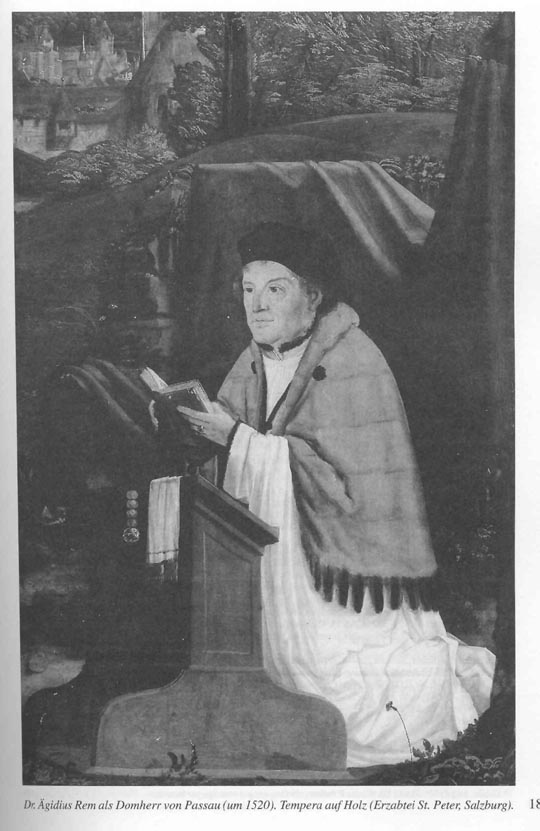Bishop
Rem(us)
of Chiemsee

Aegridus Rem(us) of Augsburg was a man of great learning and skills. He
had an outstanding education. He was an important advisor to Cardinal Lang of
Salzburg on matters of religion and Catholic Church reform. He served the last
ten years of his life as the Bishop of Chiemsee (a
diocese about half way between Munich and Salzburg) within the realm of the Archbishop of Salzburg,
Cardinal Mattaus Lang. He was intimately involved in efforts to reform the
Catholic Church at the time of the Reformation.
On this page is a sketch of his life. Click
the links for more details.
Aegridus Rem (Aegridus
translates to English as Giles) was born to the Augsburg Patricians Lucas Rem and Magdelena Welser. This family is shown both by the original family
name Rem (Rehm) and by the
Latinized version Remus. Rem is a German clan name
found in southern Germany. The Latinizing of names was commonly done in time of
the Renaissance. The Rem(us) was a patrician family that thrived on the trade
between Augsburg and Venice. Aegridus was born around
1485 (not 1500 as listed in some sources). He had a brother Hans (Johan) Rem who married into another patrician family of Augsburg
and Munich, the family of Matthaus Lang. Click here
to find out more about the Rem(us) family in Augsburg.
Aegridus Rem was educated at three universities,
the universities of Padua (1509/1513) in Northern Italy, University of Pavia
(1512/1513) just south of Milan, and University of Paris by 1514. His fields
were theology and law. He was a humanist and corresponded with the most famous
humanist of the time, Erasmus.
Aegridus Rem upon the completion of
his education became a key advisor for Cardinal Matthaus
Lang of Salzburg. At the time (1515),
the Catholic Church was badly in need of reform. Problems of drink, financial
mismanagement and the keeping of concubines were widespread as well as just
plain neglect of religious duties.

Aegridus Rem also spent time in Rome in 1523/24 as a representative of Cardinal Lang.

�In
that capacity, he met the Pope and conveyed messages between the Pope and the
Cardinal. He failed, however, to convince the Pope to allow the Bishops to
discipline the clerics and monastics within their
domain. Instead, the Pope left the discipline to the secular authorities. This
was why Luther was protected in spite of his views and why many German
municipalities and states were easily converted to Lutheranism. This is also
why reform efforts within the church failed until the Council of Trent well
after Rem's death.
Both Lang and Rem
whole-heartedly supported the need for church reform and began to institute such a reform within the archdiocese of Salzburg. Rem was the key architect of the reform documents such as
those of the Muehldorf
Convention of 1522. Click here for a picture of
Muehldorf in that era. In spite of such actions, the movement started by Luther
gained momentum. All this religious turmoil led to the Peasant's War and the peasant's three month siege of the high fortress of Salzburg (Rem
was inside the fortress for those three months). Click on the latter link to
find out more about the creation of term Stierwascher
and what that had to do with Bishop Rem. His siege experience was very
influential in getting Dr. Aegidius Rem to write "Bellum rusticum
Saltzpurgense", which appeared on 11 November
1525.

Within a year of the resignation of Berthold Purstinger, the Bishop of Chiemsee, Aegridus Rem was appointed the new Bishop of Chiemsee
(1526). Here is a picture of his
church.

He was still active in reform at both the
diocese and archdiocese level. He died in Chiemsee on
9 September 1535. Here is a map of the Archbishopric of Salzburg including Chiemsee Dioses.
Bishop Rem's major
work still exists in several libraries in Germany. It is titled "Rusticum Salztburgense descriptum" published in Saltzburg
in 1525.
Large parts of the above were adapted from From Sallaberger, Johann Kardinal Matth�us Lang von Wellenburg : (1468 - 1540) ; Staatsmann und Kirchenf�rst im Zeitalter von Renaissance, Reformation und Bauernkriegen / Salzburg ; M�nchen : Pustet, 1997. - 544 S. : Ill. ISBN 3-7025-0353-6
Please
send any queries to Bill Remus at
August
9, 2007